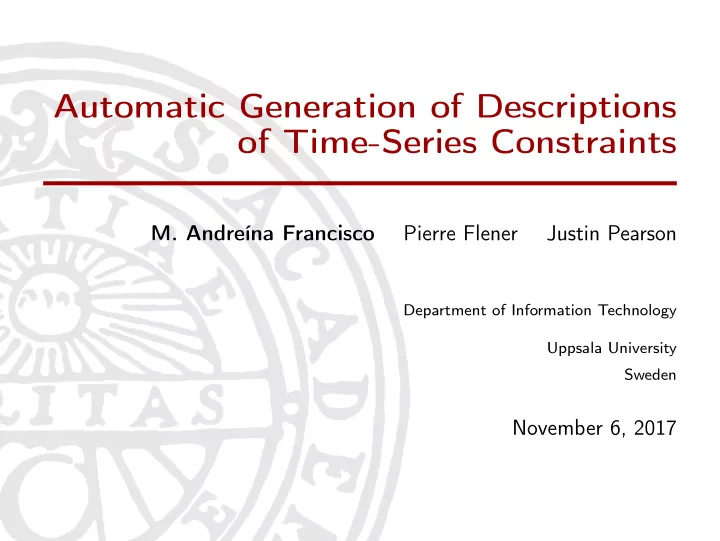

Automatic Generation of Descriptions of Time-Series Constraints Pierre Flener Justin Pearson M. Andreína Francisco Department of Information Technology Uppsala University Sweden November 6, 2017
Take-away points � High-level way of describing constraints over sequences of variables. � Automatically-synthesised constraint decompositions. � New family of constraints for time-series. � Applications in data analysis as well as optimisation. 2 of 14
Background: Combinatorial optimisation Combinatorial optimisation consists of finding an object from a finite set of objects: � The set of feasible solutions is discrete or can be discretised. � The goal is to find a solution, or all solutions, or a best solution. � Examples: � puzzles: sudoku, nonograms, etc. � the nurse scheduling problem. Constraint programming (CP) is a set of techniques and tools for effectively modelling and efficiently solving hard combinatorial problems. CP solving = propagation + search 3 of 14
Background: CP Modelling Constraints form the vocabulary of a CP modelling language: they allow a modeller to express commonly occurring substructures. Example The AllDifferent ( x , y , z ) constraint, over the variables x , y , and z with domains x ∈ { 1 , 2 } , y ∈ { 1 , 2 } , and z ∈ { 2 , 3 , 4 , 5 } , holds if and only if the variables x , y , and z take pairwise distinct values. A constraint model is a conjunction of constraints. Example AllDifferent ( x , y , z ) ∧ x + y < z 4 of 14
Background: CP Propagation and Search A constraint comes with a propagator , which removes impossible values from the domains of its variables. Example AllDifferent ( x , y , z ) with x = { 1 , 2 } , y = { 1 , 2 } , and z = { ✁ ❆ 2 , 3 , 4 , 5 } After the propagators have removed the values they can, the solver will begin a systematic search if need be: � Select a variable � Select a value (or a range of values) � Propagate again on the domain of the variables Example x = 1: AllDifferent ( x , y , z ) , x = { 1 , ✁ ❆ 2 } , y = { ✁ ❆ 1 , 2 } , and z = { 3 , 4 , 5 } 1 , 2 } , y = { 1 , ✁ x � = 1: AllDifferent ( x , y , z ) , x = { ✁ ❆ ❆ 2 } , and z = { 3 , 4 , 5 } 5 of 14
Background Although modern CP solvers have many built-in constraints, often a constraint that one is looking for is not there. In such cases, the choices are: � to reformulate the model without the needed constraint; � to write a propagator for the new constraint; � to decompose the constraint into a conjunction of constraints with already existing propagators. For example, the constraint AllDifferent ( x , y , z ) can be decomposed into x � = y ∧ x � = z ∧ y � = z . 6 of 14
Example: g _ f _Peak 7 4 4 4 4 4 2 2 2 2 2 2 2 0 0 5 0 0 6 0 = = = = = = = = = > < < < > > < > 7 of 14
Time-series constraint [CP’15] N. Beldiceanu, M. Carlsson, R. Douence, H. Simonis . “Using finite transducers for describing and synthesising structural time-series constraints” A time-series constraint g _ f _ σ ( � X 1 , . . . , X n � , M ) is defined by: � A pattern σ is a regular expression over the alphabet { <, = , > } , e.g. Peak = ‘<(<|=)*(>|=)*>’. Only 22 patterns in the Time-Series Constraint Catalogue. � A feature f is a function over a subseries: one , max , min , surface , width . � An aggregator g is a function over the features: Sum , Min , Max . where the variable sequence � X 1 , . . . , X n � is a time series and variable M is the result of aggregating using g the feature values computed using f of all the maximal words matching σ in � X 1 , . . . , X n � . 8 of 14
Our research in context pattern generate specifies feature + aggregator transducer synthesise (CP’15, CPAIOR’16) describes automaton constraint derive derive induce (CP’14, CP’16) (ICTAI’13, GCAI’15, CPAIOR’16) (CP’04, CPAIOR’16) glue constraints implied constraints decomposition 9 of 14
Before > : out ρ s feature, aggregator < : out = : out < : maybe before > : in > : found ρ r ρ t = : maybe before = : maybe after < : out after constraint decomposition 10 of 14
Pros and cons Pros � Transducers, together with features and aggregators, are a convenient and high-level way for synthesising automata describing time-series constraints. � Automatically-synthesised automaton-induced decompositions. Cons � Transducers need to be designed and verified by hand. � Requires understanding the output alphabet of the transducers. � Prone to errors. 11 of 14
Now pattern (for example: Peak = ‘<(<|=)*(>|=)*>’) feature aggregator constraint decomposition 12 of 14
Results � Our tool generates exactly the same transducers as in [CP’15]. � The obtained transducers are well-formed (correct). � Now the Time-Series Constraint Catalogue can be extended at will. 13 of 14
The work on time-series constraints has been done in collaboration with / by: � Ekaterina Arafailova � Nicolas Beldiceanu � Mats Carlsson � Rémi Douence � Helmut Simonis The authors are supported by grants 2012-4908 and 2015-0491 of the Swedish Research Council (VR).
Recommend
More recommend